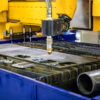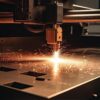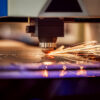Laser cutting has become a cornerstone technology in modern manufacturing, offering unparalleled precision, versatility, and efficiency. This article delves into the fascinating world of laser cutting, exploring its processes, benefits, applications, and potential future developments.
What is Laser Cutting?
Laser cutting is a non-contact, thermal cutting process that harnesses the power of a focused laser beam to melt, burn, or vaporize material. This technique can be applied to a wide array of materials, including metals, plastics, wood, and fabrics.
The Laser Cutting Process
- Beam Generation: A laser source generates a high-energy laser beam.
- Beam Focusing: The beam is focused through lenses or mirrors onto the workpiece.
- Material Interaction: The concentrated laser energy rapidly heats the material, causing it to melt or vaporize.
- Gas Assist: A high-pressure gas jet (often oxygen or nitrogen) is used to remove molten or vaporized material, ensuring a clean cut.
Types of Laser Cutting Machines
- CO2 Lasers: Commonly used for cutting non-metals and some metals.
- Fiber Lasers: Ideal for cutting metals with high precision and speed.
- Nd:YAG Lasers: Versatile lasers used for cutting, welding, and marking various materials.
Advantages of Laser Cutting
Laser cutting boasts a multitude of advantages over traditional cutting methods, making it a preferred choice for many industries:
- Precision: Laser cutting offers exceptional accuracy and repeatability, enabling the production of intricate designs and complex geometries.
- Versatility: A wide range of materials can be cut using lasers, from thin sheets to thick plates.
- Speed and Efficiency: Laser cutting is a fast process, especially for thinner materials, leading to increased production rates.
- Non-Contact Cutting: Unlike mechanical cutting methods, laser cutting does not involve physical contact with the material, reducing wear and tear on tools and minimizing contamination.
- Minimal Heat Affected Zone (HAZ): The laser beam’s focused energy creates a small HAZ, preserving the integrity of the surrounding material.
- Automation: Laser cutting machines are easily automated, leading to reduced labor costs and increased productivity.
- Reduced Waste: Laser cutting allows for optimized material usage, minimizing scrap and waste.
- Flexibility: Designs can be easily modified and adapted, offering greater flexibility for customization.
Advantages of Laser Cutting
Laser cutting finds applications across a diverse range of industries:
- Manufacturing: Production of metal parts, electronic components, automotive parts, and aerospace components.
- Fabrication: Creation of custom-made products, signage, architectural features, and art installations.
- Textile Industry: Cutting of fabrics for clothing, upholstery, and technical textiles.
- Medical Devices: Production of intricate medical implants and instruments.
- Electronics: Manufacturing of circuit boards and microelectronics.
- Jewelry: Creation of intricate jewelry designs and engraving.
The Future of Laser Cutting
The future of laser cutting looks promising, with ongoing research and development focusing on:
- Increased Power and Speed: Advancements in laser technology will lead to even faster and more powerful cutting capabilities.
- New Materials: Lasers will be able to cut a wider variety of materials, including composites and ceramics.
- 3D Laser Cutting: This emerging technology will enable the creation of complex 3D shapes and structures.
- Integration with Artificial Intelligence: AI-powered laser cutting systems will offer greater automation, optimization, and quality control.
Laser cutting has transformed the manufacturing landscape, empowering industries with precision, speed, and flexibility. As technology continues to advance, laser cutting is poised to play an even greater role in shaping the future of manufacturing and innovation.








